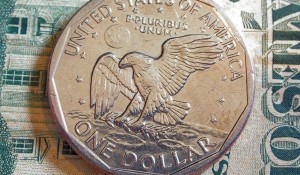Why Does The U.S. Mint Continue Making $1 Coins If They Aren’t Being Used?
1.1 billion dollar coins sit in United States vaults, awaiting the day – if ever – that they see the light of day in circulation. The United States Mint will make millions more dollar coins in 2016 as it wraps up the Presidential $1 coin program with the Ronald Reagan dollar and also strikes the Native American dollar coins. Yet, why did the nation continue striking dollar coins even years after the December 11, 2011 decision to stop making dollar coinage for circulation?
In part, it has to do with U.S. law, which passed coinage acts permitting, and requiring, the United States Mint to strike the Presidential dollar coins and Native American dollar coins for the entirety of their originally intended series duration. However, the failure of the Presidential dollar to circulate led to the United States Treasury's decision to pull production of the coins for circulation, even though the series was still on schedule for another five years.
What's going on? Why are more than 1 billion dollar coins collecting dust in vaults? Apparently the American public has little interest in using dollar coins. According to a 2011 poll, 77 percent of respondents said the paper dollar is more convenient to use than the dollar coin. 86 percent said the paper dollar is more widely accepted, and 75 percent said they don't want a dollar coin or find it unnecessary altogether.
What would happen if the dollar bill were replaced with a dollar coin? According to the General Accountability Organization, the United States could save $4.4 billion over the course of 30 years if coins replace paper currency; dollar coins, which cost about 12 cents each to make, last an average of 30 years in circulation, while dollar bills, which cost about 5.4 cents each, have an average lifespan of 18 months to five years.
The United States Mint has tried at least twice since the late 1970s to persuade Americans to embrace small-size dollar coins, starting with the introduction of the Susan B. Anthony dollar in 1979. The plan flopped, and production of the coin ended in 1981. The Susan B. Anthony dollar was temporarily resurrected in 1999 to provide a supply of new coins for use in postage stamp vending machines and transit tollbooths. With the debut of the gold-colored Sacagawea dollar coin in 2000, the U.S. Mint and other pro-dollar coin advocates hoped Americans would have a change of heart and trade in their paper currency for dollar coins.
However, Americans held onto their dollar bills. And they do to this day. It would likely take a complete removal of paper dollars, as Canada did in the late 1980s with the introduction of its dollar coin, to induce widespread use of dollar coins in United States circulation. Until then, dollar bills will continue to reign. And 1.1 billion dollar coins will continue languishing in federal bank vaults.
-
{{#owner}}
-
{{#url}}
{{#avatarSrc}}
{{name}} {{/url}} {{^url}} {{#avatar}} {{& avatar}} {{/avatar}} {{name}} {{/url}} - {{/owner}} {{#created}}
- {{created}} {{/created}}

